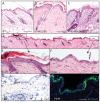Adult epidermal Notch activity induces dermal accumulation of T cells and neural crest derivatives through upregulation of jagged 1
- PMID: 20940224
- PMCID: PMC2964092
- DOI: 10.1242/dev.050310
Adult epidermal Notch activity induces dermal accumulation of T cells and neural crest derivatives through upregulation of jagged 1
Abstract
Notch signalling regulates epidermal differentiation and tumour formation via non-cell autonomous mechanisms that are incompletely understood. This study shows that epidermal Notch activation via a 4-hydroxy-tamoxifen-inducible transgene caused epidermal thickening, focal detachment from the underlying dermis and hair clumping. In addition, there was dermal accumulation of T lymphocytes and stromal cells, some of which localised to the blisters at the epidermal-dermal boundary. The T cell infiltrate was responsible for hair clumping but not for other Notch phenotypes. Notch-induced stromal cells were heterogeneous, expressing markers of neural crest, melanocytes, smooth muscle and peripheral nerve. Although Slug1 expression was expanded in the epidermis, the stromal cells did not arise through epithelial-mesenchymal transition. Epidermal Notch activation resulted in upregulation of jagged 1 in both epidermis and dermis. When Notch was activated in the absence of epidermal jagged 1, jagged 1 was not upregulated in the dermis, and epidermal thickening, blister formation, accumulation of T cells and stromal cells were inhibited. Gene expression profiling revealed that epidermal Notch activation resulted in upregulation of several growth factors and cytokines, including TNFα, the expression of which was dependent on epidermal jagged 1. We conclude that jagged 1 is a key mediator of non-cell autonomous Notch signalling in skin.
Figures








References
-
- Aho S. (2004). Soluble form of Jagged1: unique product of epithelial keratinocytes and a regulator of keratinocyte differentiation. J. Cell Biochem. 92, 1271-1281 - PubMed
-
- Ambler C. A., Watt F. M. (2007). Expression of Notch pathway genes in mammalian epidermis and modulation by beta-catenin. Dev. Dyn. 236, 1595-1601 - PubMed
-
- Botchkarev V. A., Eichmuller S., Johansson O., Paus R. (1997). Hair cycle-dependent plasticity of skin and hair follicle innervation in normal murine skin. J. Comp. Neurol. 386, 379-395 - PubMed
Publication types
MeSH terms
Substances
Grants and funding
LinkOut - more resources
Full Text Sources
Other Literature Sources
Molecular Biology Databases

